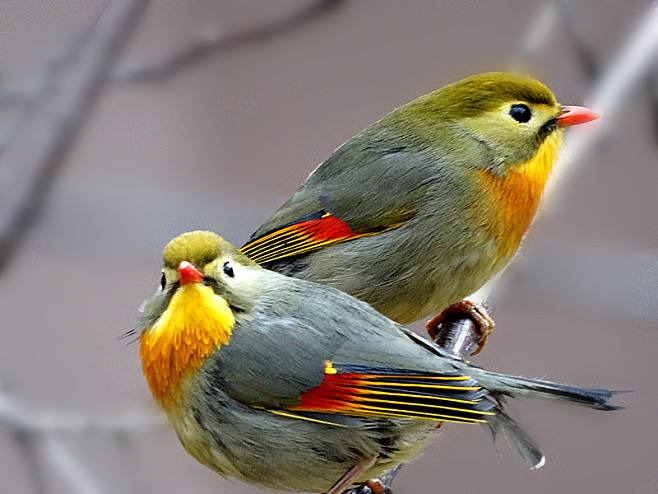Leiothrix lutea
IUCN
LCBasic Information
Scientific classification
- name:Leiothrix lutea
- Scientific Name:Leiothrix lutea,Red-billed Leiothrix,Pekin Robin,Lovebird, red-billed jade, colorful lovebird, red-billed bird
- Outline:Songbird
- Family:Passeriformes T.family Acacia
Vital signs
- length:12-15cm
- Weight:14-29g
- lifetime:About 10 years
Feature
With its colorful feathers and melodious singing voice, it is one of the famous caged ornamental birds around the world.
Distribution and Habitat
Existing: Bhutan, China, India, Myanmar, Nepal, Pakistan and Vietnam.
Existing (breeding ground): Hong Kong, China.
Existing and introduced (breeding ground): Japan, Reunion Island and the United States.
Existing and introduced (resident bird): France and Italy.
In China, it is distributed in southern Gansu, southern Shaanxi, the Yangtze River Basin and the provinces in southern China to the south, east to Zhejiang and Fujian, south to Guangdong, Hong Kong, Guangxi, west to Sichuan, Guizhou, Yunnan and southern Tibet. It mainly inhabits mountain evergreen broad-leaved forests, evergreen deciduous mixed forests, bamboo forests and sparse forests and shrubs at the edge of forests at an altitude of 1200-2800 meters. In winter, it often goes down to low mountains, foothills, plains and river valleys below 1000 meters above sea level, and sometimes enters the bushes near villages, courtyards and farmlands.
Appearance
The red-billed Acacia male's forehead, head, pillow and upper back are olive green with yellow, the forehead and front of the head are slightly lighter, the lower back, waist and tail coverts are dark gray olive green, and the longest tail coverts are lighter. Yellow end spots. The tail is forked and shiny black. The outer tail feathers are slightly curved outward. The central tail feathers are dark gray olive green with metallic blue-black end spots. The outer feathers and end spots of the outer tail feathers are metallic blue-green, and the base of the inner feathers is dark gray olive green. The wing coverts are also mostly dark olive green, and the flight feathers are dark brown, darkening inward, becoming brilliant black. The outer edge of the primary flight feathers is yellow, gradually turning into golden yellow inward. Starting from the third primary flight feather, the base of the outer outer part of the primary flight feathers is vermilion, forming a conspicuous vermilio
Details
Red-billed Leiothrix has 5 subspecies.

Red-billed Leiothrix is a resident bird. Except for the breeding period, it usually moves in pairs or alone. In other seasons, it usually moves in small groups of 3-5 or more than 10, and sometimes it also moves in mixed groups with other small birds. It is bold and not afraid of people. It often shuttles, jumps, and flies between trees or bushes under the forest. It occasionally moves and forages on the ground. It is good at singing, especially during the breeding period, its singing voice is loud and melodious.
The breeding season of Red-billed Leiothrix is from May to July. It usually nests in the undergrowth or in the bushes or bamboo bushes at the edge of the forest. The nests are mostly built on the side branches of the bushes or on the branches of small trees or bamboo branches, 1-1.5 meters above the ground. It is in the shape of a deep cup, mainly composed of moss, grass stems, grass leaves, leaves, bamboo leaves, bark, grass roots and other materials, and is padded with fine grass stems, palm fibers and fibrous roots. The size of the nest is 8-12.6 cm in outer diameter, 5-8 cm in inner diameter, 6-8 cm in height, and 5-6 cm in depth. Each clutch contains 3-4 eggs, which are white or greenish-white with ochre or lavender spots, especially densely at the blunt end. The eggs are 20.2-24.3 mm × 16.2-16.4 mm in size and weigh 2.4-3.0 g.
The global population of the Red-billed Leiothrix has not been determined, but the species is reported to be locally common (Grewal et al, 2002), while the global population is estimated to be about 10,000-100,000 breeding pairs in China and about 100-10,000 breeding pairs in Japan. The population is suspected to be declining due to continued habitat destruction and capture for the cage trade (del Hoyo et al, 2007).
On May 24, 2022, Jimu News reporters learned from Huanggang Normal University that the Dabie Mountain Flora and Fauna Diversity and Conservation Team of the school and the Wildlife and Plant Protection Unit of the Luotian County Forestry Bureau discovered a population of more than 20 red-billed leiothrixes in high-altitude mountainous areas during a survey of alien invasive species in forest and wetland ecosystems in the Dabie Mountain Nature Reserve. This discovery is the first report of red-billed leiothrixes in the area.
It is included in the "List of Terrestrial Wildlife with Important Economic and Scientific Research Value Protected by the State" (Item 510) issued by the State Forestry Administration of China on August 1, 2000.
Listed in Appendix I, II and III of the Convention on International Trade in Endangered Species of Wild Fauna and Flora (CITES) 2019 Edition Appendix II.
Listed in the IUCN Red List of Threatened Species in 2016 ver 3.1 - Least Concern (LC).
Listed in China's National List of Key Protected Wildlife (February 5, 2021) Level II.
Protect wildlife and eliminate game.
Maintaining ecological balance is everyone's responsibility!








